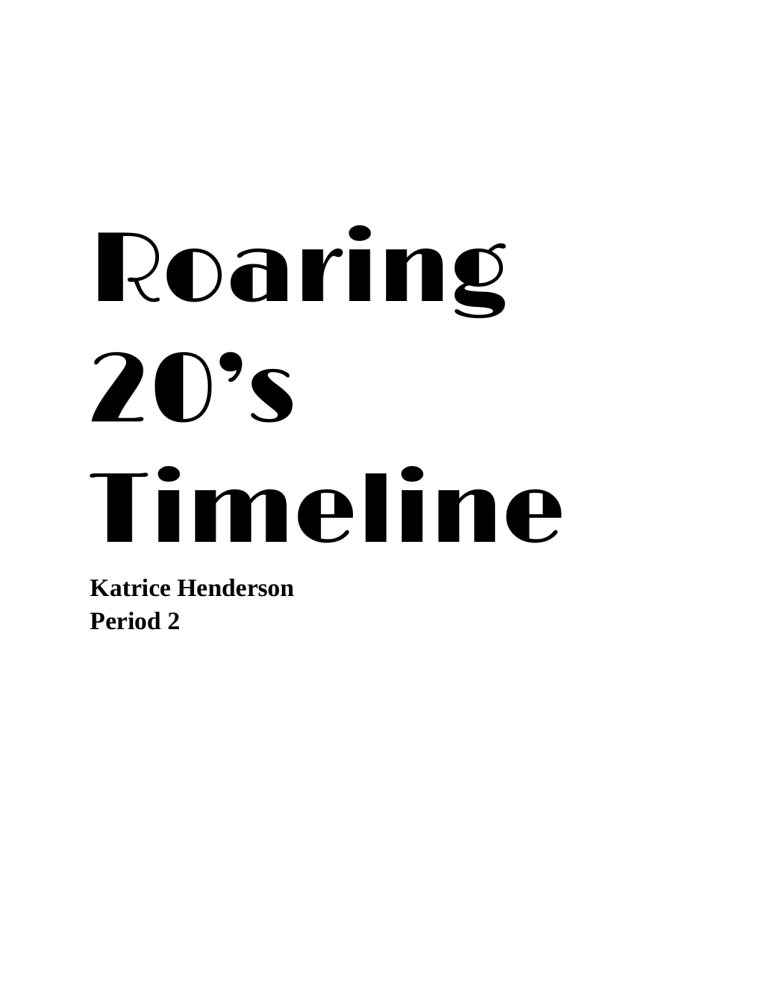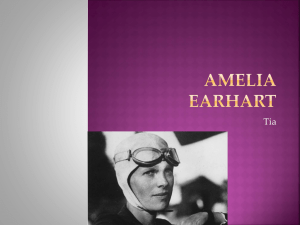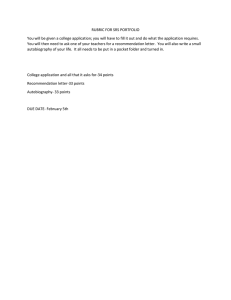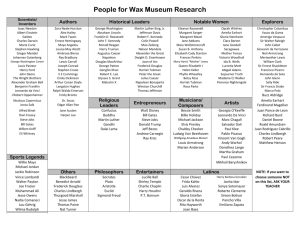
Roaring 20’s Timeline Katrice Henderson Period 2 19th Amendment Date- June 4, 1919 The 19th amendment, which was approved on August 18, 1920, gave women the right to vote. The right to vote for women in America is legally protected under the 19th amendment. This accomplishment needed a protracted and challenging battle; triumph required decades of activism and resistance. Women started organizing, petitioning, and picketing in the 1800s to get the right to vote, but it took them decades to succeed. Advocates for women's voting rights put in a lot of effort between 1878, when the amendment was originally proposed in Congress, and August 18, 1920, when it was passed, although their methods for doing so differed. Some followed a strategy of passing suffrage bills in every state; by 1912, nine western states had done so. Male-only voting laws were contested in court by others. Some suffragists used more aggressive strategies, including picketing, silent vigils, and hunger strikes. Supporters frequently faced vehement opposition. They were physically beaten, detained, and heckled by opponents. Palmer Raids Date- October 7, 1919 The Palmer Raids, also known as Palmer Red Raids, were raids carried out by the US Department of Justice in 1919 and 1920 in an effort to apprehend foreign anarchists, communists, and extreme leftists; many of these suspects were later deported. Attorney General A. Mitchell Palmer oversaw the raids, which are regarded as the pinnacle of the so-called Red Scare of that time period and were motivated by societal unrest after World War I. The Palmer Raids directly contributed to the founding of the American Civil Liberties Union, or ACLU, in 1920. The National Civil Liberties Bureau was proposed to be reorganized as the ACLU at a meeting on January 13. The ACLU conducted its initial meeting on January 19. The ACLU originally took legal action against the Sedition Act. The rights of free expression and the freedom of the press guaranteed by the First Amendment were blatantly violated by the raids. The Fifth Amendment's due process requirement was also broken during the raids since numerous people were held and arrested without proper justification. Great Migration Date- 1910-1970 One of the biggest migrations of individuals in American history was known as the Great Migration. Between the 1910s and the 1970s, around six million Black Americans relocated from the American South to northern, midwestern, and western states. After being denied citizenship in the South, Black Americans found a new position in public life in the cities of the North and West, ushering in a new age of rising political activism. This activism had a direct positive impact on the civil rights struggle. The United States' involvement in and impacts from both World Wars are sometimes used to divide the Great Migration into two stages. Black southerners were relocated to northern and mid-western cities during the First Great Migration (1910–1940), notably New York, Chicago, Detroit, and Pittsburgh. More physically fit men were dispatched to fight in Europe as the war effort increased in 1917, leaving their industrial employment unfilled. A fall in European immigration as well as ongoing restrictions on persons of color from other regions of the world put additional pressure on the labor market. All of this gave Black people the chance to be the labor supply for non-agricultural sectors. Charles Linbergh Date- February 4, 1902 - August 26, 1974 For successfully completing the first solo, nonstop flight between New York City and Paris, Charles Lindbergh is best remembered as a global hero. Lindbergh was not just a superb pilot but also a leader in the early conservation movement, an amateur scientist, and an innovator. According to mnhs.org, Six renowned aviators had already lost their lives while competing for the Orteig Prize, a prize of $25,000 to the first aviator of any Allied country crossing the Atlantic in one flight, from Paris to New York, by the time Lindbergh was prepared to take off. Unfazed, Lindbergh decided to attempt the record-breaking flight on May 20, 1927. He was unable to sleep, so he awoke at 1:40 am and left for the airstrip an hour later to supervise preparations. Amelia Earhart Date- July 24, 1897 - disappeared July 2, 1937 Amelia was the first female pilot to fly solo across the Atlantic in 1932. She received the French Legion of Honor Cross as well as the American Distinguished Flying Cross. Earhart contributed to the establishment of the Ninety-Nines, a group for female aviators, in 1929. In addition to her flying accomplishments, Amelia Earhart is renowned for inspiring women to defy restrictive societal expectations and seek a variety of opportunities, particularly in the aviation industry. By believing that women could attain the same success as their male counterparts, demonstrating it could be done, and inspiring other women, Amelia Earhart improved the world—at least for women. By flying to 14,000 feet in 1922, Amelia Earhart broke the record for the highest height attained by a female pilot. Earhart made history by becoming the first woman to fly across the Atlantic Ocean six years later. Invention of Radio Date-1895 Gugliemo Marconi, a young Italian inventor, created what he labeled "the wireless telegraph" in 1895 while conducting experiments in his parents' attic. He transmitted Morse code using radio waves, and the device he employed is now known as the radio. Radio stood out among other mass media because it could be accessed by everyone, including those who were illiterate. The emotional effect of catastrophic events was brought home to the listening public by radio news in the 1930s and 1940s, which helped the country feel united. In order to give listeners the most recent changes, radio broadcasts can provide real-time information that is disseminated 24 hours a day. Stations can cross borders and serve as a source of information in areas where dependable news is hard to come by. With its remarkable capacity to communicate important developments from throughout the world, radio completely altered the landscape of mass media. As a result, information transmission became simple and common. As the primary medium for broadcast news by the early 20th century, radio started to transform the world. Jazz Age Date- Early 1920s - 1929 The Jazz Age, commonly referred to as the Roaring Twenties, was a period in American history that began following World War I and came to an end in 1929 with the start of the Great Depression. But the social and cultural legacies of the time are still felt now and have an impact on American life. With the introduction of numerous innovations and way of life choices that are still prevalent in American society today, the 1920s drastically altered living in America. The era also witnessed the development of the vehicle, commercial radio, electric appliances, telephone, ready-made apparel in conventional sizes, and home phonograph records, which helped spread music. Synthetic textiles were widely used, cigarette smoking and cosmetic use increased, and advertising adopted a far more graphic and psychological approach than in the past. Additionally, Americans started using chain stores for their shopping and eating more canned and frozen food and less home-cooked food. In essence, the Jazz Age was the birthplace KKK Revival Date- 1915 - Around 1940s The American nativist culture served as the forefather of the Klan in the 20th century. Col. William J. Simmons founded it in 1915 in the vicinity of Atlanta, Georgia. Until Edward Y. Clarke and Elizabeth Tyler contributed their skills as publicists and fundraisers, the new organization remained small. More importantly, the resurrected Klan represented the defensive reaction of white Protestants in small-town America who felt threatened by the Bolshevik revolution in Russia and by the massive immigration of the previous decades, which had altered the ethnic makeup of American society. The resurrected Klan was motivated in part by patriotism and in part by a romantic nostalgia for the old South. The second Klan peaked in the 1920s, when it had more than 4,000,000 members nationwide and was making money from the sale of memberships. rituals, publications, regalia, and costumes. The new group adopted a burning cross as its emblem, and white-robed Klansmen engaged in nighttime cross burnings and marches across the nation. When Catholic Alfred E. Smith won the Democratic presidential nomination in 1928, the Klan had one final growth spike. The Klan's membership severely decreased during the Great Depression of the 1930s, and the few surviving Harlem Renaissance Date- 1919 - 1937 The Harlem Renaissance was the social and creative explosion that followed the early 20th-century emergence of the Harlem area in New York City as a Black cultural center. African American culture saw what is known as a "golden age" from the roughly 1910s–mid 1930s, which is reflected in literature, music, theater, and visual arts. The Harlem Renaissance, most importantly, gave African Americans across the nation a renewed sense of self-determination and pride, a new social consciousness, and a renewed commitment to political activism—all of which would serve as the cornerstone for the Civil Rights Movement of the 1950s and 1960s. A major turning point in the history of Black culture was the Harlem Renaissance. It gave African American writers and artists a voice in Western high culture and gave them more control over how Black culture and experience were portrayed. The Harlem Renaissance had a significant influence on Black awareness all over the world and provided the foundation for all subsequent African American literature. Charlie Chaplin Date- April 16, 1889 - December 25, 1977 One of the best and most adored silent film actors was Charlie Chaplin. He produced many of the funniest and most well-liked movies of his day, from "Easy Street" (1917) to "Modern Times" (1936). He was most recognized for playing the innocent and endearing Little Tramp. The art of silent film was still in its infancy, and Chaplin made significant contributions as a director, cinematographer, and even a musician. Chaplin was also a trailblazer in the movie industry as a co-founder of United Artists in 1919. Senator McCarthy, an American politician who served as a Republican U.S. Senator from the state of Wisconsin, accused Chaplin of being a communist, and a document purportedly outlining his subversive political actions since 1922 was produced. His debut "talkie," "The Great Dictator," released in 1940, heated up this charge and created a commotion.






